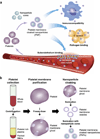Nanoparticle biointerfacing by platelet membrane cloaking
- PMID: 26374997
- PMCID: PMC4871317
- DOI: 10.1038/nature15373
Nanoparticle biointerfacing by platelet membrane cloaking
Abstract
Development of functional nanoparticles can be encumbered by unanticipated material properties and biological events, which can affect nanoparticle effectiveness in complex, physiologically relevant systems. Despite the advances in bottom-up nanoengineering and surface chemistry, reductionist functionalization approaches remain inadequate in replicating the complex interfaces present in nature and cannot avoid exposure of foreign materials. Here we report on the preparation of polymeric nanoparticles enclosed in the plasma membrane of human platelets, which are a unique population of cellular fragments that adhere to a variety of disease-relevant substrates. The resulting nanoparticles possess a right-side-out unilamellar membrane coating functionalized with immunomodulatory and adhesion antigens associated with platelets. Compared to uncoated particles, the platelet membrane-cloaked nanoparticles have reduced cellular uptake by macrophage-like cells and lack particle-induced complement activation in autologous human plasma. The cloaked nanoparticles also display platelet-mimicking properties such as selective adhesion to damaged human and rodent vasculatures as well as enhanced binding to platelet-adhering pathogens. In an experimental rat model of coronary restenosis and a mouse model of systemic bacterial infection, docetaxel and vancomycin, respectively, show enhanced therapeutic efficacy when delivered by the platelet-mimetic nanoparticles. The multifaceted biointerfacing enabled by the platelet membrane cloaking method provides a new approach in developing functional nanoparticles for disease-targeted delivery.
Figures














Comment in
-
Nanotechnology: Platelet mimicry.Nature. 2015 Oct 1;526(7571):47-8. doi: 10.1038/nature15218. Epub 2015 Sep 16. Nature. 2015. PMID: 26375011 No abstract available.
-
Platelet mimicry: The emperor's new clothes?Nanomedicine. 2016 Jan;12(1):245-8. doi: 10.1016/j.nano.2015.09.005. Epub 2015 Sep 25. Nanomedicine. 2016. PMID: 26409192
References
-
- Pelaz B, et al. Interfacing engineered nanoparticles with biological systems: anticipating adverse nanobio interactions. Small. 2013;9:1573–1584. - PubMed
-
- Salvati A, et al. Transferrin-functionalized nanoparticles lose their targeting capabilities when a biomolecule corona adsorbs on the surface. Nature Nanotech. 2013;8:137–143. - PubMed
-
- Tenzer S, et al. Rapid formation of plasma protein corona critically affects nanoparticle pathophysiology. Nature Nanotech. 2013;8:772–781. - PubMed
-
- Kieffer N, Phillips DR. Platelet membrane-glycoproteins - functions in cellular interactions. Annu. Rev. Cell Biol. 1990;6:329–357. - PubMed
Publication types
MeSH terms
Substances
Grants and funding
LinkOut - more resources
Full Text Sources
Other Literature Sources
Medical

